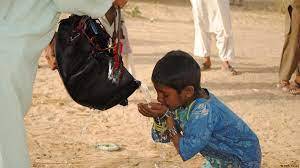
Pakistan has been blessed with natural resources but unfortunately, our policy cycle has always ignored the depletion of resources, particularly water. A few decades back, Pakistan was famous for its abundant water resources, but now due to numerous factors including policymakers' ignorance, climate change, rapid urbanisation and poor water management there is a great risk to water availability in the future.
Different research studies have highlighted how Pakistan ranks 14 out of 17 countries where water availability risk is at a very high extreme level and Pakistan ranks 36th globally when it comes to the presence of renewable water sources.
There are many reasons which directly or indirectly contribute to the depletion of water resources in Pakistan.
The lack of a comprehensive water policy is a major contributor. In May 2018 the federal government of Pakistan introduced its first water policy. After the 18th Amendment water sector came under the provincial subject and the 2018 water policy was initiated as a framework for the provinces to have their own specific water policy. However, at the federal and provincial levels, there is no comprehensive water policy.
Globally 70% of water resources are consumed by the agricultural sector, 19% by the industrial sector and 11% by the municipal sector. As Pakistan is an agricultural country, similar patterns can be observed where Pakistan's agricultural sector drains 80% of our water resources. But the real problem is the cultivation of water-intensive crops, as the main crops of Pakistan are rice, wheat, cotton, and sugar and all of them require large quantities of water. These water-intensive crops constitute less than 5% of the GDP.
Not only do water-intensive crops degrade water resources but water distribution suffers due to poor canal systems, poor water management, and lack of pricing mechanisms all of which contribute to over-utilisation of water in the agricultural sector.
Third world countries are the most vulnerable regions to climate change and Pakistan is at the top of the list. The GLOF formation in the northern region of Pakistan has become a prominent problem. Due to GLOF formation glaciers, which are the main water reservoir in Pakistan, are melting rapidly and also due to lack of proper pre and post-invention for GLOF every year people also lose their assets in the shape of land and houses.
Another reason for water resource depletion is unplanned urbanisation and the uncontrolled increase of population rate in Pakistan. Households in big cities of Pakistan like Karachi have been facing serious water shortages for years now. Water demand is not fulfilled by the concerned authorities and consequently, this gap has been filled up by the water tank mafia causing poor households to pay PKR 8-10k for water. While the people are willing to pay for water, the pricing mechanism needs to be worked out better.
But in the current economic condition when inflation rate has touched 30%, high electricity tariffs, the introduction of a pricing mechanism for water is likely to hurt poor people further. But pricing mechanisms can be introduced without affecting poor and middle-income households if pricing mechanisms are mplemented for the agricultural sector.
In Pakistan, agricultural elites and landlords are kept out of tax bases but with the help of the water pricing mechanism, money can be collected for special criteria including landholding and the different types of cultivated crops. For municipalities, pricing can be initiated according to income/ earning level. For example, in the case of Islamabad, the socio-economic residents of the F-sector are totally different from residents of the G-sector and so using a proportional parameter pricing mechanism should be considered to ensure maximum generation of funds for water conservation efforts.
Along with the pricing mechanism, there are other multiple options available for the sustainable utilisation of water. The use of the latest technology and innovations can be helpful. In Pakistan, irrigation of crops mostly depends on the canal system, but due to lack of maintenance, water leakage leads to wastage of water. The drip irrigation method is the best way to cope with such problem.
During the monsoon season Pakistan receives several hundred millimetres of rain and with the help of rainwater harvesting, there should be a system in place to store water for our future. There are many ways to rainwater harvesting such as dry systems, wet systems, rain barrels and green roofs.
The concept of ‘Reuse and Recycle’ also has potential for the conservation of water. Most of the water utilised by households can be reused and recycled. In addition, a considerable amount of water used for industrial processes can also be re-used. Along with all these steps awareness about the importance and sustainable use of water needs to be disseminated so that we can achieve SDG 6 which states: “Ensure availability and sustainable management of water and sanitation for all”.

